FN 5.7×28mm
The FN 5.7×28mm (designated as the 5.7 × 28 by the C.I.P.[7]) is a small-caliber, high-velocity, smokeless powder, rebated rim, bottlenecked centerfire cartridge designed for handgun and personal defense weapon (PDW) uses and manufactured by FN Herstal.[8] It is similar in length to the .22 WMR (Winchester Magnum Rimfire)(5.7×27mm) and to some degree similar also to .22 Hornet or .22 K-Hornet.[8] Unlike many new cartridges, it has no parent case; the complete package was developed from scratch by FN.
| 5.7×28mm | ||||||||||||||||
|---|---|---|---|---|---|---|---|---|---|---|---|---|---|---|---|---|
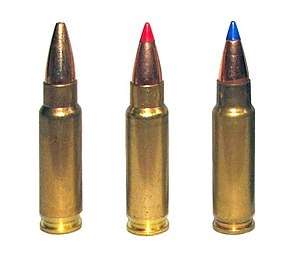 5.7×28mm sporting cartridges. From left to right: SS195LF, SS196SR, and SS197SR. | ||||||||||||||||
| Type | Personal defense weapon | |||||||||||||||
| Place of origin | Belgium | |||||||||||||||
| Service history | ||||||||||||||||
| In service | 1991–present [1] | |||||||||||||||
| Used by | 40+ nations; see: | |||||||||||||||
| Wars |
| |||||||||||||||
| Production history | ||||||||||||||||
| Designer | ||||||||||||||||
| Designed | ||||||||||||||||
| Manufacturer | FN Herstal | |||||||||||||||
| Produced | ||||||||||||||||
| Variants | See Varieties | |||||||||||||||
| Specifications | ||||||||||||||||
| Case type | Rebated rim, bottleneck | |||||||||||||||
| Bullet diameter | 5.70 mm (0.224 in) | |||||||||||||||
| Neck diameter | 6.38 mm (0.251 in) | |||||||||||||||
| Shoulder diameter | 7.95 mm (0.313 in) | |||||||||||||||
| Base diameter | 7.95 mm (0.313 in) | |||||||||||||||
| Rim diameter | 7.80 mm (0.307 in) | |||||||||||||||
| Rim thickness | 1.14 mm (0.045 in) | |||||||||||||||
| Case length | 28.90 mm (1.138 in) | |||||||||||||||
| Overall length | 40.50 mm (1.594 in) | |||||||||||||||
| Case capacity | 0.90 cm3 (13.9 gr H2O) | |||||||||||||||
| Rifling twist | 228.6 mm ( 1 in 9 inch) | |||||||||||||||
| Primer type | Boxer Small Rifle | |||||||||||||||
| Maximum pressure | 345.00 MPa (50,038 psi) | |||||||||||||||
| Ballistic performance | ||||||||||||||||
| ||||||||||||||||
| Test barrel length: 263 mm (10.35 in) Source(s): [7] | ||||||||||||||||
The 5.7×28mm was developed in conjunction with the FN P90 PDW and FN Five-seven pistol, in response to NATO requests for a replacement for the 9×19mm Parabellum cartridge.[9][10] In 2002 and 2003, NATO conducted a series of tests with the intention of standardizing a PDW cartridge as a replacement for the 9×19mm Parabellum cartridge.[10] The tests compared the relative merits of the 5.7×28mm cartridge and the 4.6×30mm cartridge, which was created by Heckler & Koch as a competitor to the 5.7×28mm.[10] The NATO group subsequently recommended the 5.7×28mm cartridge, citing superior performance in testing, but the German delegation objected and the standardization process was indefinitely halted.[10]
By 2006, FN's 5.7×28mm firearms—the P90 PDW and Five-Seven pistol—were in service with military and police forces in over 40 nations throughout the world.[11] In the United States, 5.7×28mm firearms are currently used by numerous law enforcement agencies, including the U.S. Secret Service.[12][13]
In addition to being used in the FN P90 and FN Five-seven firearms, the 5.7×28mm cartridge has subsequently been used in a number of other weapons, such as the AR-57 and FN PS90 carbines.[14][15] Excel Arms has developed four firearms chambered in 5.7×28mm, MasterPiece Arms offers three different firearms in 5.7×28mm.[16][17], and CMMG offers several of its AR-Style Banshee firearms in 5.7x28[18]. In December, 2019, Ruger announced its new Ruger-57 semi-automatic pistol chambered in this cartridge. [19]
The 5.7×28mm cartridge itself is produced in a number of varieties, two of which—the SS195LF and SS197SR—are currently offered by FN to civilian shooters.[14]
History
Development
The 5.7×28mm cartridge was designed in response to NATO requests for a replacement for the 9×19mm Parabellum cartridge.[10][20] According to the NATO requirement, the new cartridge was to have greater range, accuracy, and terminal performance than the 9×19mm cartridge.[21] Additionally, it was to be capable of penetrating body armor.[21] FN Herstal responded to the NATO requirement by developing the 5.7×28mm cartridge and two associated weapons: the FN P90 personal defense weapon (PDW) and FN Five-seven pistol.[20]
The original 5.7×28mm cartridge, called the SS90, was introduced in 1990.[20] It used a 1.5 gram (23 grain) plastic-core projectile, which was propelled at a muzzle velocity of roughly 850 m/s (2,800 ft/s or Mach 2.5) when fired from the P90.[20] A United States patent application for the projectile design used in the SS90 was filed by FN's Jean-Paul Denis and Marc Neuforge in 1989.[5] U.S. Patent 5,012,743 ("High-Performance Projectile") was received in 1991.[6][22]
When fired from the FN P90, the 5.7×28mm SS190 can penetrate the NATO CRISAT vest or a Level IIIA Kevlar vest at a range of 200 m (219 yd).[23][24]
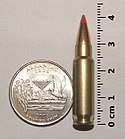
The 5.7×28mm SS90 cartridge was discontinued, and replaced, in 1993, with the 5.7×28mm SS190.[6] The SS190 uses a 2.7 mm (0.11 in) shorter projectile with a weight of 2.0 g (31 grains), which has, when fired from the P90, a muzzle velocity of roughly 715 m/s (2,350 ft/s).[23] The shorter length of the SS190 projectile allows it to be more conveniently used in the 5.7×28mm FN Five-seven pistol, which was also being developed at that time.[6]
In 1993, FN introduced a modified version of the P90 with a magazine adapted to use the SS190 cartridge.[6] Several specialized 5.7×28mm varieties were also developed alongside the SS190, such as the L191 tracer round and the subsonic SB193 bullet for sound-suppressed use.[14] The 5.7×28mm chambered FN Five-seven pistol then went into production in 1998.[25]
NATO evaluation
In 2002 and 2003, NATO conducted a series of tests with the intention of standardizing a PDW cartridge as a replacement for the 9×19mm Parabellum.[10] The tests compared the relative merits of the 5.7×28mm cartridge and the HK 4.6×30mm cartridge, which was created by German small arms manufacturer Heckler & Koch as a competitor to the 5.7×28mm.[10] The results of the NATO tests were analyzed by a group formed of experts from Canada, France, the United Kingdom, and the United States, and the group's conclusion was that the 5.7×28mm was "undoubtedly" the more efficient cartridge.[10]
Among other points, the NATO group cited superior effectiveness (27 percent greater) for the 5.7×28mm against unprotected targets and equal effectiveness against protected targets.[10] It also cited less sensitivity to extreme temperatures for the 5.7×28mm, and cited a greater potential risk of barrel erosion with the 4.6×30mm.[10] In addition, the group pointed out that 5.7×28mm is close to the 5.56×45mm NATO by its design and manufacture process, allowing it to be manufactured on existing production lines.[10] The group also noted that 5.7×28mm firearms had existed for a longer period of time than 4.6×30mm firearms, and that the 5.7×28mm FN Five-seven pistol was already in production at that time, while the 4.6×30mm Heckler & Koch UCP pistol was a new concept.[10]
However, the German delegation and others rejected the NATO recommendation that 5.7×28mm be standardized, halting the standardization process indefinitely.[10][21] As a result, both the 4.6×30mm and 5.7×28mm cartridges (and the associated weapons) have been independently adopted by various NATO countries, according to preference; both the P90 and Five-seven are currently in service with military and police forces in over 40 nations throughout the world.[10]
Present
In 2004, the SS192 hollow-point cartridge was introduced to civilian shooters alongside the new IOM variant of the Five-seven pistol.[26] After being met with controversy, the SS192 variety was discontinued in the same year, and in 2005 the SS196SR variety was introduced using a 2.6 g (40 grain) Hornady V-Max projectile.[27][28] The SS196 was also quickly discontinued in favor of the newer SS195LF and SS197SR varieties, which are currently offered to civilian shooters for use in 5.7×28mm firearms, followed by the SS198LF variety, which is currently produced but is restricted by FN to military and law enforcement customers.[14]
FN's 5.7×28mm ammunition types were briefly manufactured by Olin-Winchester, but today they are made by FN Herstal in Belgium and (since 2006) Fiocchi in the United States.[8][29] In 2009, the National Rifle Association added 5.7×28mm firearms to its NRA Tactical Police Competition standards, allowing law enforcement agencies to compete in this event using 5.7×28mm firearms.[30] Starting in 2012, Federal began producing a new 5.7×28mm round for civilian shooters, designated the AE5728A.[17]
Design details
The 5.7×28mm cartridge was designed by FN Herstal specifically for use in the FN P90 personal defense weapon and FN Five-seven pistol.[9] Subsequently, it has been used in a number of other weapons, such as the FN PS90 carbine and the AR-57, an upper receiver for M16 and AR-15 rifles.[14][15] The ST Kinetics CPW can be configured for the 5.7×28mm cartridge by changing the barrel and magazine groups.[31] Excel Arms has developed four firearms chambered in 5.7×28mm,[16] and MasterPiece Arms offers three different 5.7×28mm firearms.[17]
The 5.7×28mm cartridge weighs 6.0 grams (93 grains)—roughly two-thirds as much as a typical 9×19mm Parabellum cartridge—making extra ammunition less burdensome, or allowing more ammunition to be carried for the same weight.[32][33][34] Since the 5.7×28mm cartridge also has a relatively small diameter, a relatively high number of cartridges can be contained in a magazine.[35] The cartridge has a loud report and produces considerable muzzle flash (when fired from a pistol),[36] but it has roughly 30 percent less recoil than the 9×19mm cartridge, improving controllability.[24][34][37] Due to its high velocity, the 5.7×28mm also exhibits an exceptionally flat trajectory.[34][38]
One of the design intents of the SS190 variety of this cartridge was that it have the ability to penetrate Kevlar protective vests—such as the NATO CRISAT vest—that will stop conventional pistol bullets.[24] Fired from the P90, the SS190 is capable of penetrating the CRISAT vest at a range of 200 m (219 yd), or a Level IIIA Kevlar vest at the same range.[23][24] However, sporting variants of the 5.7×28mm are classified by the U.S. Bureau of Alcohol, Tobacco, Firearms and Explosives (ATF) as not armor-piercing.[27]
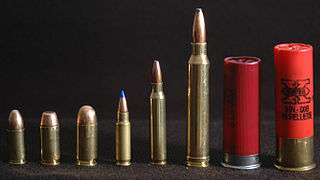
According to FN, the 5.7×28mm cartridge has an effective range of 200 m (219 yd) and a maximum range of 1,800 m (1,969 yd) when fired from the P90,[29] and an effective range of 50 m (55 yd) and a maximum range of 1,510 m (1,651 yd) when fired from the Five-seven.[26] In testing, the SS190 and similar 5.7×28mm projectiles consistently turn base over point ("tumble") as they pass through ballistic gelatin and other media, using the 21.6 mm (.85 in) projectile length[26] to create a larger wound cavity.[9][33][39][40] However, some are skeptical of the bullet's terminal performance, and it is a subject of debate among civilian shooters in the United States.[40]
The 5.7×28mm projectile potentially poses less risk of collateral damage than conventional pistol bullets, because the projectile design limits overpenetration, as well as risk of ricochet.[39][41][42] The lightweight projectile also poses less risk of collateral damage in the event of a miss, because it loses much of its kinetic energy after traveling only 400 m (437 yd), whereas a conventional pistol bullet such as the 9×19mm retains significant energy beyond 800 m (875 yd).[38] This range exceeds the engagement distances expected for the 5.7×28mm cartridge's intended applications, so the cartridge's limited energy at long range is not conversely considered to be disadvantageous.[38]
Since the 5.7×28mm SS190 projectile does not rely on fragmentation or the expansion of a hollow-point bullet, the cartridge (and 5.7×28mm firearms) are considered suitable for military use under the Hague Convention of 1899, which prohibits the use of expanding bullets in warfare.[40]
FN's 5.7×28mm cartridge cases are covered with a special polymer coating for easier extraction with the PS90 carbine due to the high chamber pressures and lack of case tapering.[33] In addition, this coating ensures proper feeding and function in the magazines.[33]
Cartridge dimensions
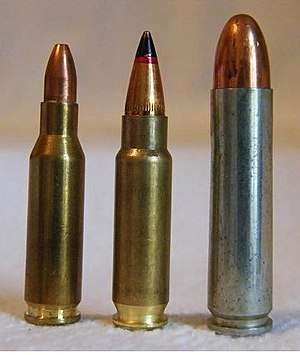
The 5.7×28mm has a cartridge case capacity of 0.90 ml (13.85 grains H2O).[36]
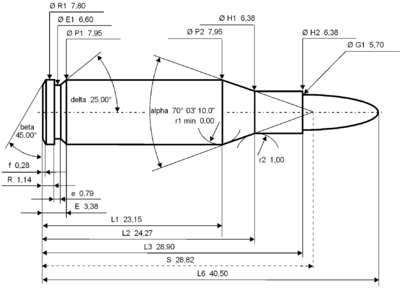
Americans define the shoulder angle at alpha/2 ≈ 35 degrees. The common rifling twist rate for this cartridge is 1:228.6 mm (1:9 in), 8 grooves, Ø lands = 5.53 mm, Ø grooves = 5.62 mm, land width = 1.63 mm and the recommended primer type is small rifle.[7]
According to the official C.I.P. (Commission Internationale Permanente pour l'Epreuve des Armes à Feu Portatives) rulings, the 5.7×28mm can handle up to 3,450 bar (345 MPa; 50,000 psi) Pmax (the nominal maximum) piezo pressure. In C.I.P. regulated countries, every rifle cartridge combination has to be proofed at 125% of this maximum C.I.P. pressure to be certified for sale to consumers, referred to as "PE". This means that 5.7×28mm chambered arms in C.I.P. regulated countries are currently (2018) proof tested at 4,313 bar (431.3 MPa; 62,550 psi) PE piezo pressure.[7]
Cartridge types
- SS90 prototype
- The SS90 was an early prototype round used only in the earliest examples of the P90. It used a lightweight 1.5-g (23 grain) full metal jacket bullet with a polymer core, which it propelled at a muzzle velocity of roughly 850 m/s (2,800 ft/s). The SS90 was abandoned in 1994 in favor of the heavier and shorter 2.7 mm (0.11 in) SS190 projectile.[20]
- SS190 duty
- The SS190 FMJ, a refinement of the SS90, was introduced in 1993.[6] It offered superior performance over the prototype projectile as well as slightly reduced length.[6] The latter change allowed it to be used more conveniently in the Five-seven pistol, also being developed at that time.[20] Fired from the P90, the SS190 propels a 2.0-g (31 grain) bullet at a muzzle velocity of roughly 715 m/s (2,350 ft/s). It has a steel penetrator and an aluminum core.[43] The SS190 has been manufactured with a plain, black, and a black-on-white tip color.[14][44][45] It is classified by the ATF as armor-piercing (AP) handgun ammunition, and its sale is currently restricted by FN to military and law enforcement customers.[14][27]
- In testing done by Houston Police Department SWAT, the SS190 fired from the P90 into bare ballistic gelatin exhibited penetration depths ranging from 28 to 34 cm (11 to 13.5 in).[23] In testing in 1999 by the Royal Canadian Mounted Police (RCMP), the SS190 fired from the P90 at a distance of 25 m (27 yd) exhibited an average penetration depth of 25 cm (9.85 in) in ballistic gelatin after passing through a Level II Kevlar vest.[41]
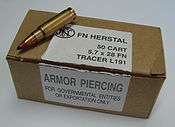
- L191 tracer
- The L191 (also formerly called the SS191)[46] is a tracer cartridge designed for easier bullet spotting in dim light.[14] Combustible chemicals packed in the rear of the L191 projectile create a light trail visible up to 200 m (219 yd).[45] The L191 has been manufactured with red and red-on-black tips.[14][44] The performance and trajectory of the L191 is identical to the SS190.[32][34] For this reason, it is also classified by the ATF as armor-piercing handgun ammunition, and its sale is currently restricted by FN to military and law enforcement customers.[14][27]
- SS192 hollow-point
- The SS192 was discontinued in late 2004.[46] It used a 1.8 g (28 grain) hollow point bullet with a copper jacket and an aluminum core.[26] The projectile had a length of 21.6 mm (.85 in).[26] It had an unmarked hollow nose with a depth of 7.6 mm (0.3 in) and a 0.8 mm (0.03 in) opening.[26] The SS192 was classified by the ATF as not armor-piercing, and in testing by FNH USA it did not penetrate a Level IIIA vest when fired from the Five-seven.[27]
- SB193 subsonic
- The SB193 (also formerly called the SS193)[46] is a subsonic cartridge featuring a 3.6-g (55 grain) Sierra Game King FMJBT (FMJ boat tail) projectile. The SB193's sub-sonic speed eliminates the distinctive "crack" created by supersonic rounds. The muzzle report is also reduced when using the sub-sonic ammunition together with a suppressor. Due to the greatly decreased muzzle velocity, the SB193 benefits from a slightly reduced recoil force of 1.3 kgm/s.[47] The SB193 can be identified by its white tip color.[14] Its sale is currently restricted by FN to military and law enforcement customers.[14]
- T194 training
- The T194 training round was discontinued in 2002. It could be considered an early version of the SS192 or SS195. It used the same 1.8-g (28 grain) copper-jacketed aluminum core bullet, propelled at the same muzzle velocity.[32] It had a green tip.[32]
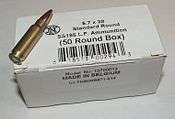
- SS195LF (lead free)
- The SS195LF is a commercially available cartridge that features a lead-free primer and produces ballistics similar to the SS192 round, which it replaced in late 2004.[46] It uses the same 1.8-g (28 grain) copper-jacketed aluminum core bullet as the SS192, and it can be identified by the unmarked, hollow void at the tip and the silver-colored primer.[14] The SS195 is classified by the ATF as not armor-piercing, and it is currently manufactured by FN Herstal in Belgium.[8][27]
- SS196SR (sporting round)
- The SS196SR was introduced in 2005 and it is now discontinued in favor of the SS197SR cartridge.[28] It featured a lead core 2.6-g (40 grain) Hornady V-Max bullet which it propelled at a muzzle velocity of roughly 500 m/s (1,650 ft/s) when fired from the Five-seven.[28] The polycarbonate tip used in the V-Max bullet acted as a wedge, enhancing expansion of the bullet. The SS196 was classified by the ATF as not armor-piercing, and in testing by FNH USA it did not penetrate a Level II vest when fired from the Five-seven.[27] The SS196 could be identified by its red polymer tip.[46]
- SS197SR (sporting round)
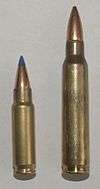
- The SS197SR is currently offered to civilian shooters in addition to the SS195LF.[14] It uses the same lead core 2.6-g (40 grain) Hornady V-Max projectile as the SS196SR,[8] but it is loaded for a muzzle velocity roughly 30-m/s (100 ft/s) higher. The projectile has a blue-colored polymer tip instead of the red color used in the SS196 projectile tip.[14] The SS197 has been manufactured by Fiocchi, under contract for FN Herstal, since 2006[8][48][49] and it is distributed in the United States by Federal Cartridge Company.[14]
- SS198LF (lead free)
- The SS198LF uses the same lead-free projectile and primer as the SS195LF,[44] but propels it at roughly a 30-m/s (100 ft/s) higher muzzle velocity. It’s manufactured in Belgium. It has a green painted tip, and its sale is currently restricted by FN to military and law enforcement customers,[14] but is widely available through retailers to civilian customers.
- American Eagle (AE5728A) TMJ
- Since 2012, Federal Cartridge Company markets a loading produced by Fiocchi using a 5.7×28mm round under their American Eagle brand.[17] Designated the AE5728A, this cartridge uses a 40-grain total metal jacket (TMJ) projectile, that is atypical in that it does not use a copper-plated bullet; sectioned pictures show a very thick full copper jacket. The AE5728A casings are of FN manufacture, and the muzzle velocity is slightly lower than that of the SS197SR.
- Non-FN ammunition
- Elite Ammunition manufactures a wide variety of loaded 5.7×28mm ammunition offerings, including the "T6B" and "S4M" cartridges.[50] Belgian ammunition manufacturer VBR-Belgium has also developed specialized 5.7×28mm projectiles designed for armor penetration and controlled fragmentation.[51]
- Ammunition is also produced by several small companies Detroit Ammunition R&R ELP Vanguard Desert Ammo
- Handloading is possible with 5.7×28mm ammunition, and 5.7mm (.224 in) bullets are widely available due to use in .223 Remington and 5.56×45mm NATO cartridges.[8] Handloaders have noted that the 5.7×28mm cartridge is very sensitive to small changes in powder charge or overall length (OAL) with a bullet inserted.[36] Bullets weighing 2.6 g (40 grains) or less are recommended for optimal use in 5.7×28mm applications,[36] but the 228.6 mm (1:9 in) rifling twist rate (distance the bullet must travel to complete one full revolution) used in the firearms' barrels will stabilize bullets weighing up to 4.5 g (70 grains).[8]
Specifications
| Name | SS190 | L191 | SS192 | SB193 | T194 | SS195LF | SS196SR | SS197SR | SS198LF | AE5728A | T6B | S4M |
|---|---|---|---|---|---|---|---|---|---|---|---|---|
| Projectile mass | 2.0 g (31 gr) | 2.0 g (31 gr) | 1.8 g (28 gr) | 3.6 g (56 gr) | 1.8 g (28 gr) | 1.8 g (28 gr) | 2.6 g (40 gr) | 2.6 g (40 gr) | 1.8 g (28 gr) | 2.6 g (40 gr) | 2.1 g (32 gr) | 1.8 g (28 gr) |
| Muzzle velocity (P90) | 716 m/s (2,350 ft/s) | 716 m/s (2,350 ft/s) | 716 m/s (2,350 ft/s) | 305 m/s (1,000 ft/s) | 716 m/s (2,350 ft/s) | 716 m/s (2,350 ft/s) | 549 m/s (1,800 ft/s) | 594 m/s (1,950 ft/s) | 792 m/s (2,600 ft/s) | 583.6 m/s (1,915 ft/s) | 762 m/s (2,500 ft/s) | 930.6 m/s (3,053 ft/s) |
| Muzzle energy (P90) | 534 J (394 ft⋅lb) | 534 J (394 ft⋅lb) | 467 J (344 ft⋅lb) | 163 J (120 ft⋅lb) | 467 J (344 ft⋅lb) | 467 J (344 ft⋅lb) | 393 J (290 ft⋅lb) | 461 J (340 ft⋅lb) | 482 J (356 ft⋅lb) | 441 J (325 ft⋅lb) | 604 J (445 ft⋅lb) | 788 J (581 ft⋅lb) |
| Projectile type | FMJ "AP" | FMJ tracer | JHP | FMJBT | JHP | JHP | V-Max | V-Max | JHP | TMJ | Turned Exotic Solid Copper | JHP |
| Effective range | 200 m (660 ft) | 200 m (660 ft) | 200 m (660 ft) | 50 m (160 ft) | 200 m (660 ft) | 200 m (660 ft) | 150 m (490 ft) | 150 m (490 ft) | 200 m (660 ft) | 200 m (660 ft) | 200 m (660 ft) | 200 m (660 ft) |
| Color code | Plain, black or white/black | Red or red/black | Plain JHP | White | Green | Plain JHP | Red V-Max | Blue V-Max | Green | Plain TMJ | Anodized Black | Plain JHP |
| Availability | Restricted by FN | Restricted by FN | Commercial (discontinued) | Restricted by FN | Restricted by FN (discontinued) | Commercial | Commercial (discontinued) | Commercial | Restricted by FN | Commercial | Commercial | Commercial |
Fired from the longer 40.74 cm (16.04 in) barrel of the PS90, the muzzle velocity of SS195LF is roughly 60 m/s (200 ft/s) faster, and the muzzle velocity of SS197SR is roughly 45 m/s (150 ft/s) faster.[43] Fired from the shorter 12.2 cm (4.8 in) barrel of the Five-seven pistol, the muzzle velocity of SS195LF is roughly 90 m/s (300 ft/s) slower, and the muzzle velocity of SS197SR is roughly 60 m/s (200 ft/s) slower.[43] [52][53]
See also
References
- Díez, Octavio (2000). Armament and Technology: Handguns. Barcelona: Lema Publications, S.L. ISBN 9788484630135.
- "Special Forces: Tout Sauf des Rambo". La Libre Belgique (in French). March 25, 2006. Retrieved February 6, 2010.
- Harris, Byron (March 16, 2009). "Texas is arming Mexican drug cartels". Dallas Morning News. Archived from the original on August 15, 2010. Retrieved April 27, 2010.
- Fux, Eric (April 21, 2011). "Bericht van het front in Libië" (in Dutch). De Redactie. Archived from the original on May 1, 2011. Retrieved May 2, 2011.
- Watters, Daniel E. "The 5.56 × 45mm Timeline: 1986–1989". The Gun Zone. Archived from the original on February 10, 2011. Retrieved June 21, 2010.
- Watters, Daniel E. "The 5.56 × 45mm Timeline: 1990–1994". The Gun Zone. Archived from the original on January 4, 2010. Retrieved January 31, 2010.
- C.I.P. TDCC datasheet 5,7 × 28
- Forker, Bob (May 28, 2008). "The 5.7×28 FN". Guns & Ammo. Archived from the original on 2010. Retrieved October 19, 2009.
- Miller, David (2001). The Illustrated Directory of 20th Century Guns. London: Salamander Books Ltd. ISBN 9781840652451.
- Oliver, David (2007). "In the Line of Fire". Global Defence Review. Archived from the original on October 16, 2006. Retrieved October 19, 2009.
- Francotte, Auguste; Claude, Gaier; Robert, Karlshausen, eds. (January 2008). Ars Mechanica – The Ultimate FN Book. Vottem: Herstal Group. ISBN 9782874158773.
- Wood, J.B. "FNH USA Five-seveN Pistol 5.7×28mm". Tactical Life. Retrieved October 18, 2009.
- Baddeley, Adam (May 21, 2003). "NATO Delays Personal Weapon Choice". Jane's Defence Weekly - Infantry Equipment (ISSN 0265-3818), p 30.
- "FNH USA Products – 5.7x28mm Ammunition". FNH USA. 2012. Archived from the original on September 4, 2012. Retrieved August 31, 2012.
- Crane, David (August 11, 2008). "AR Five Seven (AR-57): 50-Shot 5.7×28mm AR-15 Carbine". Defense Review. Retrieved October 19, 2009.
- "New Models X-5.7R and X-5.7P". Excel Arms. 2010. Archived from the original on November 22, 2010. Retrieved October 27, 2010.
- "New MasterPiece Arms MPA 5.7x28mm Series Pistols". AmmoLand. June 25, 2012. Retrieved July 21, 2012.
- "Pistols and SBRs Archives". CMMG Inc. Retrieved 2020-06-16.
- "Tested: Ruger-57 Pistol". National Rifle Association. December 31, 2019. Retrieved January 4, 2020.
- Marchington, James (2004). The Encyclopedia of Handheld Weapons. Miami: Lewis International, Inc. ISBN 9781930983144.
- Gourley, S.; Kemp, I (November 26, 2003). "The Duellists". Jane's Defence Weekly (ISSN 0265-3818), Volume 40 Issue 21, pp 26–28.
- "U.S. Patent 5,012,743 (High-Performance Projectile)". United States Patent and Trademark Office. Archived from the original on January 6, 2017. Retrieved July 15, 2010.
- Wall, Sandy (April 2003). "Spring 2003 Experiences with the FN P90". Hendon Publishing Co. Archived from the original on July 11, 2011. Retrieved October 19, 2009.
- Fortier, David (2008). "Military Ammo Today". Handguns Magazine. Archived from the original on January 22, 2010. Retrieved October 19, 2009.
- Hogg, Ian (2002). Jane's Guns Recognition Guide. Jane's Recognition Guides. Glasgow: Jane's Information Group and Collins Press. ISBN 9780007127603.
- Sterett, Larry S. (2005). "FN 5.7mm Five-seveN Pistol Makes Civilian Model Debut". Gun Week. Archived from the original on October 29, 2012. Retrieved October 19, 2009.
- "FN 5.7 (Fabrique Nationale) Pistol is a Semiautomatic Pistol in 5.7 × 28 mm Caliber". Bureau of Alcohol, Tobacco, Firearms and Explosives. January 20, 2005. Retrieved October 3, 2009.
- "New Sporting Round from FN Herstal USA". Guns Magazine (ISSN 1044-6257), May 2005.
- Jones, Richard D.; Ness, Leland S., eds. (January 27, 2009). Jane's Infantry Weapons 2009/2010 (35th ed.). Coulsdon: Jane's Information Group. ISBN 9780710628695.
- "NRA Adds FN 5.7×28mm Caliber Firearms to Tactical Police Competition Standards". FNH USA. May 14, 2009. Archived from the original on December 23, 2010. Retrieved January 3, 2010.
- "Compact Personal Weapon" (PDF). ST Engineering. Archived from the original (PDF) on March 23, 2012. Retrieved April 6, 2010.
- "FNH USA, Inc. 5.7×28mm Weapon System". FNH USA. 2002. Archived from the original on December 25, 2002. Retrieved February 1, 2010.
- Detty, Mike (October 2008). "FNH 5.7×28mm Dynamic Duo". Special Weapons For Military & Police. Retrieved November 21, 2009.
- "Big Scale Progress for Small Arms". Global Defence Review. 2002. Archived from the original on May 15, 2008. Retrieved October 19, 2009.
- Amselle, Jorge (November 2011). "FN FIVE-SEVEN 5.7×28mm". Special Weapons For Military & Police. Retrieved November 9, 2011.
- Rodriguez, Greg (2008). "Favorite Loads: Hot Off The Press – 5.7×28mm". Shooting Times. Archived from the original on 2009. Retrieved February 1, 2010.
- Massad Ayoob (April 16, 2010). "Defensive Handguns – The FN Five-seveN". On Target magazine. Archived from the original on October 2, 2011. Retrieved January 28, 2010.
- Kevin, Dockery (2007). Future Weapons. New York: Berkley Trade. ISBN 9780425217504.
- Humphries, Michael O. (May 2008). "Radical Tactical Firepower". Tactical Weapons. Retrieved October 20, 2009.
- Bahde, Dave (November 2009). "FNH Five-seveN ODG 5.7×28mm". Combat Handguns. Retrieved November 28, 2009.
- Cutshaw, Charlie (May 2006). "FN Herstal's Five-seveN Pistol". Tactical Response.
- "Five-seveN Facts" (PDF). FNH USA. November 9, 2009. Retrieved September 18, 2010.
- "FNH USA 2008 Product Catalog – 5.7×28mm Ammunition" (PDF). FNH USA. 2008. Archived from the original (PDF) on July 11, 2011. Retrieved January 30, 2010.
- "FNH USA 2009 Product Catalog" (PDF). FNH USA. 2009. Archived from the original (PDF) on July 11, 2011. Retrieved February 1, 2010.
- "The 5.7×28mm SS190 Ammunition". FN Herstal. 2002. Archived from the original on 2002. Retrieved October 15, 2011.
- "Responses to Frequently Asked Questions about 5.7×28mm Ammunition and Firearms Systems". FNH USA. 2006. Archived from the original on April 11, 2006. Retrieved February 1, 2010.
- "5.7×28mm Ammunition". FN Manufacturing LLC. 2000. Archived from the original on December 12, 2002. Retrieved February 1, 2010.
- "FNH USA Partners with Fiocchi". Shooting Industry (ISSN 0037-4148), January 2006.
- "FNH USA Maintains Steady Pricing and Plentiful Supply of 5.7×28mm Ammunition Despite Demand". FNH USA. September 27, 2007. Archived from the original on December 23, 2010. Retrieved October 19, 2009.
- "Elite Ammunition Custom 5.7x28mm Amuunition". Elite Ammunition. 2019. Retrieved October 21, 2010.
- "VBR-Belgium and the 5.7x28 mm caliber". VBR-Belgium. Retrieved June 10, 2011.
- "Archived copy". Archived from the original on 2016-09-24. Retrieved 2016-09-23.CS1 maint: archived copy as title (link)
- https://www.cheaperthandirt.com/product/federal-american-eagle-57x28mm-total-metal-jacket-40-grain-1655fps-50-round-box-ae5728a-029465063122.do
External links
| Wikimedia Commons has media related to FN 5.7×28mm. |
- Official website
- FNH Firearms Blog
- FNH 5.7×28mm Dynamic Duo – Tactical Life
- Military Ammo Today – G&A Handguns
- 5.7×28mm Tests in Ballistic Gelatin – Brassfetcher
- 5.7x28mm Versus Body Armor – TheFirearmBlog
- Elite Ammunition
- Video